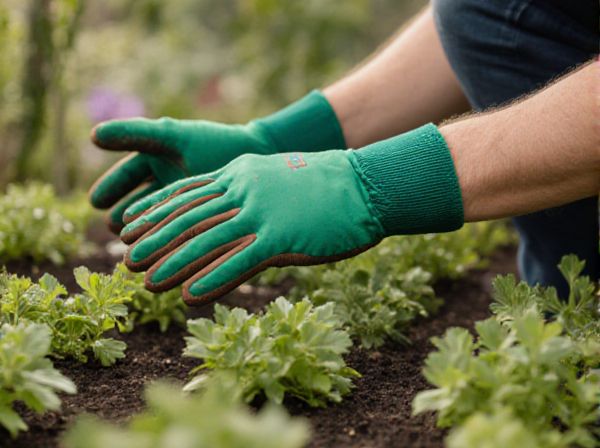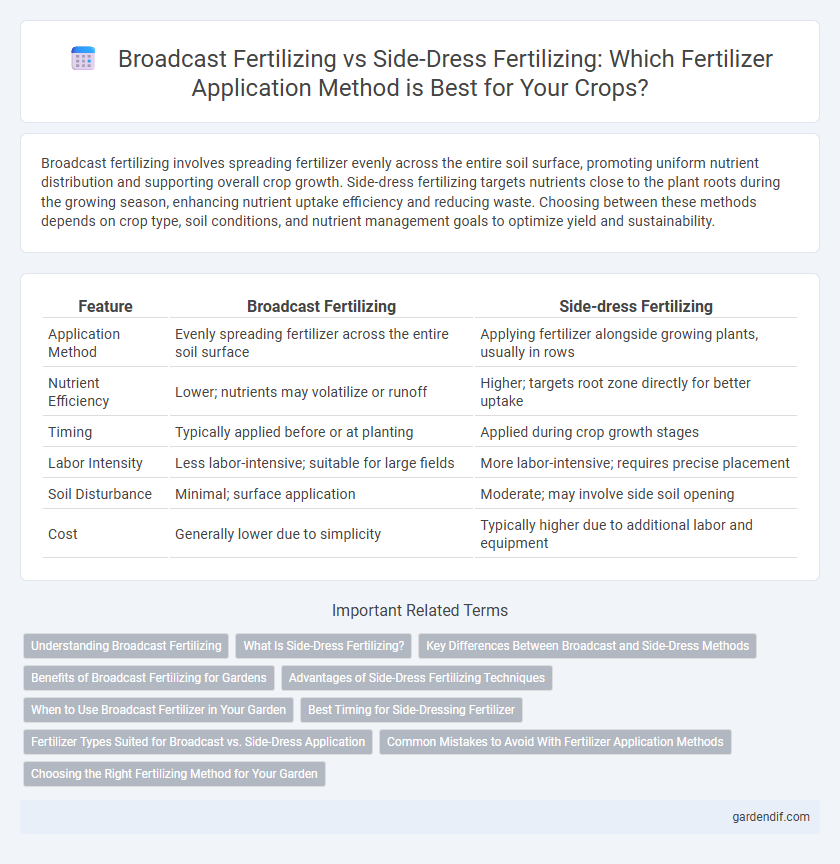
Broadcast fertilizing vs Side-dress fertilizing Illustration
Broadcast fertilizing involves spreading fertilizer evenly across the entire soil surface, promoting uniform nutrient distribution and supporting overall crop growth. Side-dress fertilizing targets nutrients close to the plant roots during the growing season, enhancing nutrient uptake efficiency and reducing waste. Choosing between these methods depends on crop type, soil conditions, and nutrient management goals to optimize yield and sustainability.
Table of Comparison
| Feature | Broadcast Fertilizing | Side-dress Fertilizing |
|---|---|---|
| Application Method | Evenly spreading fertilizer across the entire soil surface | Applying fertilizer alongside growing plants, usually in rows |
| Nutrient Efficiency | Lower; nutrients may volatilize or runoff | Higher; targets root zone directly for better uptake |
| Timing | Typically applied before or at planting | Applied during crop growth stages |
| Labor Intensity | Less labor-intensive; suitable for large fields | More labor-intensive; requires precise placement |
| Soil Disturbance | Minimal; surface application | Moderate; may involve side soil opening |
| Cost | Generally lower due to simplicity | Typically higher due to additional labor and equipment |
Understanding Broadcast Fertilizing
Broadcast fertilizing involves spreading fertilizer evenly across the entire soil surface, ensuring nutrients are readily available for early root uptake and improving crop establishment. This method is particularly effective for cereals and legumes, promoting uniform growth and maximizing nutrient use efficiency. Understanding broadcast fertilizing helps optimize application rates and timing, minimizing nutrient runoff and enhancing soil fertility management.
What Is Side-Dress Fertilizing?
Side-dress fertilizing involves applying nutrients directly alongside growing plants, targeting the root zone for enhanced nutrient uptake. This method improves efficiency by delivering essential elements such as nitrogen when the crop's demand peaks during growth stages. Compared to broadcast fertilizing, side-dress fertilizing reduces nutrient loss and promotes healthier plant development through precise application.
Key Differences Between Broadcast and Side-Dress Methods
Broadcast fertilizing involves spreading fertilizer uniformly across the entire soil surface, promoting even nutrient distribution for crops, while side-dress fertilizing places nutrients directly alongside growing plants, optimizing nutrient uptake and minimizing waste. Broadcast applications are typically used before planting to improve overall soil fertility, whereas side-dress methods are applied during the growing season to address specific nutrient deficiencies. The choice between methods depends on crop type, growth stage, and nutrient management goals.
Benefits of Broadcast Fertilizing for Gardens
Broadcast fertilizing evenly distributes nutrients across the entire garden soil surface, promoting uniform plant growth and simplifying application. This method enhances soil nutrient availability for a wide variety of crops simultaneously, reducing the risk of nutrient imbalances. Broadcast fertilizing is particularly beneficial for establishing new gardens, improving overall soil fertility and encouraging robust root development.
Advantages of Side-Dress Fertilizing Techniques
Side-dress fertilizing enhances nutrient efficiency by delivering fertilizers directly to the root zone, minimizing nutrient loss through leaching or volatilization. This targeted application promotes uniform crop growth and increases yield potential compared to broadcast methods. It also allows for timely nutrient adjustments based on crop development stages, optimizing nutrient uptake and reducing environmental impact.
When to Use Broadcast Fertilizer in Your Garden
Broadcast fertilizer is most effective when applied before planting or during early soil preparation to ensure even nutrient distribution across the entire garden bed. This method helps promote uniform seedling growth and is ideal for large areas where quick absorption of nutrients is essential. Use broadcast fertilizing when the soil nutrient levels are low, and an overall nutrient boost is needed to support germination and early plant development.
Best Timing for Side-Dressing Fertilizer
The best timing for side-dressing fertilizer is typically when crop roots are actively growing and can efficiently uptake nutrients, often occurring 3 to 6 weeks after planting. Applying fertilizer during this critical growth stage enhances nutrient use efficiency and minimizes losses compared to broadcast fertilizing, which is done before or at planting. This method is especially beneficial for nitrogen applications in crops like corn, where precise timing boosts yield potential and reduces environmental impact.
Fertilizer Types Suited for Broadcast vs. Side-Dress Application
Broadcast fertilizing commonly utilizes granular fertilizers like urea, ammonium sulfate, and NPK blends to evenly distribute essential nutrients across the soil surface. Side-dress fertilizing typically employs soluble fertilizers such as ammonium nitrate or liquid nitrogen solutions, allowing precise nutrient placement alongside growing plants for enhanced uptake. Selecting the appropriate fertilizer type based on application method optimizes nutrient efficiency and crop yield.
Common Mistakes to Avoid With Fertilizer Application Methods
Common mistakes in broadcast fertilizing include uneven distribution and applying fertilizer too close to seeds, which can cause seed burn and reduce germination rates. Side-dress fertilizing errors often involve incorrect timing or insufficient incorporation into the soil, leading to nutrient runoff and ineffective uptake by plants. Ensuring precise application rates and proper placement during critical growth stages maximizes nutrient efficiency and crop yield.
Choosing the Right Fertilizing Method for Your Garden
Broadcast fertilizing evenly distributes nutrients across the entire soil surface, ideal for established lawns or large garden areas requiring uniform nutrient coverage. Side-dress fertilizing targets the root zone by applying fertilizer in bands alongside growing plants, maximizing nutrient uptake and reducing waste for row crops or vegetable gardens. Selecting the appropriate method depends on your crop type, growth stage, and soil fertility management goals to enhance plant health and yield effectively.
Broadcast fertilizing vs Side-dress fertilizing Infographic

 gardendif.com
gardendif.com